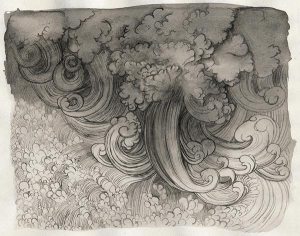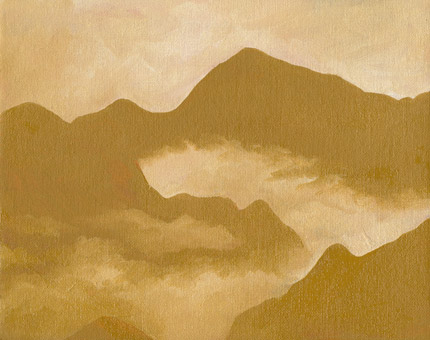It’s been awhile since I’ve done this, but over the past few months I’ve gotten various new paints from several brands in both oil and watercolor and I thought I’d make some swatches with them over the next few days.
This time I have the 1 ochre and 4 black oil paints I got from Williamsburg over the summer. Each swatch was first spread from a small blob of paint and then mixed in a roughly even mix with M Graham titanium white (PW6 + PW4). I’m pretty sure that’s the white I used. It was actually yesterday that I did these. That mix was then spread to the right of the original paint. A small amount of that was mixed again with an equal amount of white, and then again once more, for a range of increasingly lighter swatches that show the tinting strength of the paint.
All of these photos were taken today in the afternoon during overcast clouds. I can’t guarantee perfect color accuracy.

German Earth (PBk11) is natural black iron oxide. As expected of this pigment, it’s an opaque paint and a strong tinter. Williamsburg’s website describes it as “bluish” when mixed with white, but I’m really not seeing it. I’d say it’s fairly close to neutral.
Slate Black (PBk19) is actually very similar to German Earth, but less opaque. It’s apparently made from slate from Pennsylvania. Just a little bit gritty.
Davy’s Gray Deep (PBk19) is also slate from Pennsylvania but much lighter and with a warmer color. It’s very smooth and spreads surprisingly thin. I think it’d be very good at glazing. The photo doesn’t show it the best, but this was lighter than the first two in masstone. Its tinting strength is pretty low. Apparently slate comes in several colors, and as far as I can tell Williamsburg might be the only paint company that currently makes oil paint with slate. Many other brands all produce a “Davy’s Gray” of their own that is always one of various mixtures of pigments. A very unique paint.
Graphite Gray (PBk10) is made from ground graphite. It’s another unique paint that I’m glad I got. I think it looks a little lighter here than it really is because of how the light was reflecting off the paint, but this is the lightest of the four. It’s just slightly iridescent because of the graphite. I really like this one because it’s easily the bluest black paint I have.

This Lemon Ochre (PY43) is another natural iron oxide and is part of the Native Italian Earths set. I only have this one from the set. It’s a very strong earthy yellow. I really like the color a lot. Kind of gritty though.

As you can see in this closeup the vertical streaks are where tiny particles of grit were dragged along under my palette knife as I spread the paint thin. I had heard that Williamsburg’s earth pigments tended to be gritty, and at it seems least a couple of them are. While I can’t say this is a positive thing, it’s not necessarily a big deal. I mostly notice the grit in any paint from any brand, if it has any, while spreading and mixing it on my palette with a palette knife. When I’m actually brushing the paint onto a canvas I don’t really notice as much because of the different tool and surface texture.

Since I recently got some dry pigments from Natural Pigments and one of them was their version of Lemon Ochre I thought I’d make some paint myself and see how it compared. The color between the two was nearly the same, although the Williamsburg paint on the left was slightly lighter. The paint I made had a little bit higher tinting strength but I don’t have enough experience with making my own paint to know what the best proportions of oil to pigment are and I may have used too much pigment. The paint I made had a tiny bit of grit too, but noticeably much less.

Here I made an earthy green with a mix of Lemon Ochre and Graphite Gray. I really like the subtleness of it. A very natural looking green.

Just to show it, here’s what’s left of the white in the corner of my palette. Each time I get another dab of white I thoroughly wipe off my palette knife first so it doesn’t get the white messy.
Overall I really like all of these paints. My collection of black paint still doesn’t quite have all of the black pigments out there, but I’m now a lot closer to it.




























